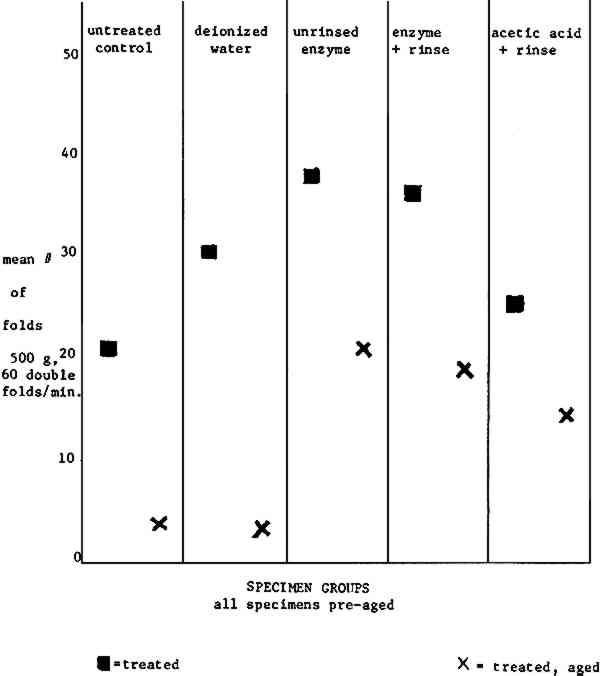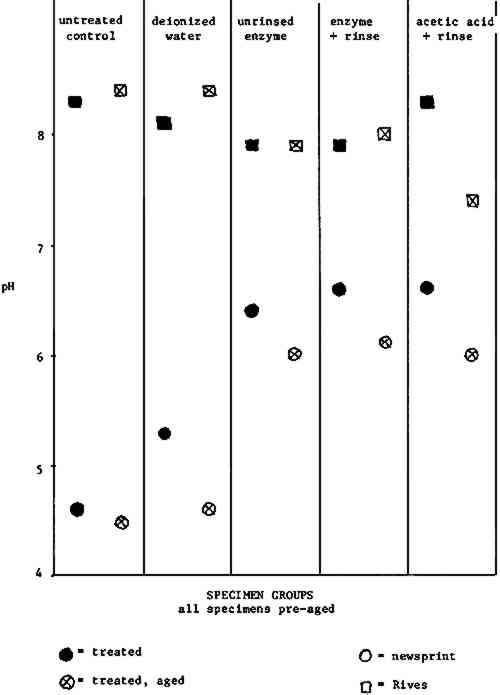SOME OBSERVATIONS ON THE USE OF ENZYMES IN PAPER CONSERVATIONPia C. DeSantis
6 RESULTSNote: All specimens were aged before treatment, or “pre-aged.” After treatment, some specimens were aged once again and will be referred to as “post-aged.” The protease derived from A.saitoi was used in all experiments. 6.1 BRIGHTNESS READINGS RIVES
Brightness test for Rives specimens which were only pre-aged do not show significant differences between the controls (columns one, two) and A.saitoi protease treated samples (columns three, four). The data in column five indicates that the acetic acid treatment slightly brightened the paper. Comparison of the post-aged and tested Rives data in column one to that in columns two through four indicates that the specimens benefitted from all wet treatments. The greatest degree of darkening after aging is seen in the untreated control and acetic acid treated specimens. In reference to the brightness readings for both Rives and newsprint specimens, it should be recalled that a dry oven was used, since humid conditions are reported to induce a more dramatic indication of a possible color change in a treated, aged paper.88 It should also be noted that a 1.0 degree difference in brightness was just perceptible to the author's eye. A difference of 2.0 degrees was noticeable, and over 3.0 degrees discrepancy could be considered an unacceptable difference. 6.2 BRIGHTNESS READINGS NEWSPRINT
According to the brightness tests for newsprint, the acetic acid treatment only slightly affected the pre-aged specimens, while the enzyme treatments maintained their brightness. It is interesting that the post-aged specimens which had received a buffered rinse (columns four and five) do not show as much darkening after aging as the untreated control and the deionized water wash control (columns one and two). It is encouraging that the A.saitoi protease treated specimens (columns three and four) yield the highest readings. (In reference to the data in column three, recall that the pH of the deionized water was about five, and that of the A.saitoi protease solution was about six.) 6.3 FOLD ENDURANCE DATA RIVESUnfortunately, the standard deviations of the fold endurance date (Table I, Fig. 1) for the tests run on Rives specimens were too great to afford the data any reliability.89 Such results are said to be typical if all specimens are not taken from one roll of paper. Researchers cannot depend on the uniformity of the sheets in a ream, since a ream is cut from a stack of rolls.90 In the case of Rives, the problem is complicated further by the sizing and fillers added to this paper during manufacture. TABLE I FOLD ENDURANCE RIVES
The data generally indicate that an aged Rives paper will benefit from a wet treatment (compare column one to columns two through five). The increase in fold endurance for all post-aged specimens except the deionized water wash control is certainly suspect. 6.4 FOLD ENDURANCE DATA NEWSPRINTThe calculated standard deviation shows that the fold endurance data (Table II, Fig. 2) for newsprint specimens are far more reliable than those for Rives specimens.91 It is encouraging that enzyme treated papers yielded higher fold endurance readings than the controls or the acetic treated specimens for both pre-aged and post-aged specimens.
TABLE II FOLD ENDURANCE NEWSPRINT It is noteworthy that the data presented here corroborate those of other studies92 in which a wash water including alkaline material apparently benefitted the papers tested (compare columns one and two to columns three through five). 6.5 PH READINGSAccording to the pH results for Rives specimens (Table III, Fig. 3), the A.saitoi treatments devised for this study removed some of the paper's buffering material.93 Specimens subjected to the acetic acid treatment produced an even lower pH reading.
Table III PH READINGS NEWSPRINT The newsprint used for these experiments does not include any buffering material, and in the light of the Rives data, it is interesting that enzyme and acetic acid treatments do not yield substantially different results for newsprint specimens (Table IV, Fig. 3). It is encouraging that newsprint specimens from the unrinsed enzyme group furnish higher pH readings than the untreated control and the deionized water wash control groups.94 |


